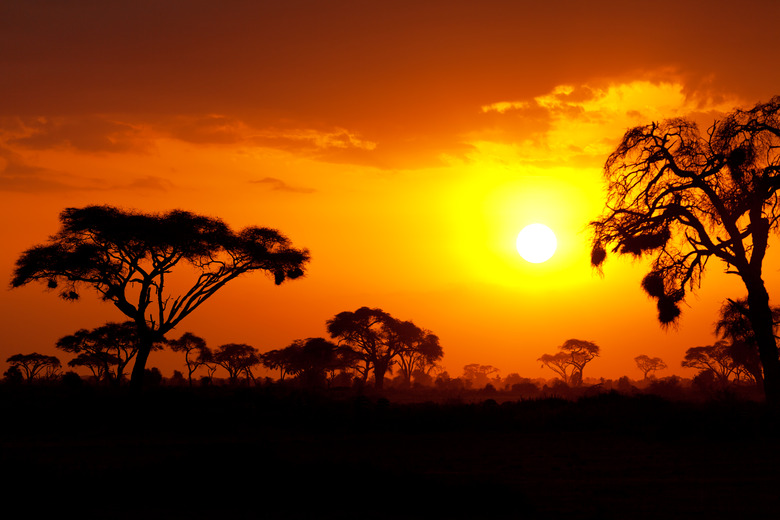General Characteristics Of The Savanna Biome
The world consists of different biomes, which are regions with similar climates, animals and plants. The five major types of biomes are aquatic, desert, forest, grassland and tundra. These can be split further. For example, savanna grassland and temperate grassland are the two main types of grassland biomes. Savanna biomes are found between tropical rainforest and desert biomes. They share certain characteristics of both.
TL;DR (Too Long; Didn't Read)
If you've ever watched a TV program about African wildlife, you've seen a savanna biome. This transitional grassland biome – somewhere between a forest and a desert – is characterized by warm temperatures, moderate rainfall, fires, seasonal droughts, coarse grasses and diverse animals.
Savanna Grassland Biome Location
Savanna Grassland Biome Location
Savannas cover half the surface of Africa and are close to the equator in India, South America and Australia. Sometimes humans create savannas when they burn grasslands and cut down trees to plant crops, and sometimes animals do. Elephants can turn a forest into a savanna by knocking down trees, stripping bark from trees and stomping on seedlings. Savannas also result from climate changes and soil conditions.
Savanna Grassland Biome Climate
Savanna Grassland Biome Climate
Savanna grassland weather is typically warm with temperatures ranging from 20 to 30 degrees Celsius (68 to 86 degrees Fahrenheit). Rainfall in the savannas is moderate, up to 75 cm per year – not enough to cause major floods. Areas with savannas have two seasons instead of four: a six-to-eight-month wet summer season and a four-to-six-month dry winter season. Lightning often strikes the ground in the dry season causing fires. Most plants lose their leaves or die off during the dry season.
Savanna Grassland Biome Plants
Savanna Grassland Biome Plants
Rhodes grass, red oats grass, star grass and lemon grass are the most common grasses in the savannas. These grasses are coarse and grow in patches across bare ground. Because rainfall is light, few trees grow, although sometimes individual trees or small groves of trees grow near streams and ponds. The baobab tree survives the savanna's dry conditions because it stores water between its bark and meat.
Savanna Grassland Biome Animals
Savanna Grassland Biome Animals
Animals in the savannas include large mammals such as African elephants, zebras, horses and giraffes native to African savannas, as well as lions, hyenas, snakes and buffaloes. More than 40 species of hoofed mammals and big cats live in the African savanna. Savannas are also home to insects. During the dry season, most birds and large animals migrate to find more plentiful water supplies. Fires are common during the dry season, but various species adapted to survive. For example, small burrowing animals dig their way deep into the ground for safety until the fire is extinguished. One bird, the fork-tailed drongo, is attracted to the fires because it eats the insects that perish in the flames.
Cite This Article
MLA
Gillespie, Claire. "General Characteristics Of The Savanna Biome" sciencing.com, https://www.sciencing.com/general-characteristics-savanna-biome-8389422/. 5 April 2018.
APA
Gillespie, Claire. (2018, April 5). General Characteristics Of The Savanna Biome. sciencing.com. Retrieved from https://www.sciencing.com/general-characteristics-savanna-biome-8389422/
Chicago
Gillespie, Claire. General Characteristics Of The Savanna Biome last modified March 24, 2022. https://www.sciencing.com/general-characteristics-savanna-biome-8389422/
